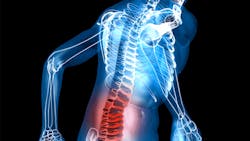Benjamin Franklin’s famous quote, “An ounce of prevention is worth a pound of cure,” has never been more apt considering the millions of Americans who suffer from back pain.
Personal trainer and author Jesse Cannone wonders how anyone can take preventative measures when most back-pain specialists take a one-dimensional perspective on this common problem after back trauma has occurred.
Most people experience significant back pain at some point in their lives; unfortunately, the response from the medical community often is surgery, which Cannone contends fails 60 percent of the time.
“The back consists of many intricate anatomical parts, all of which are dependent on the smooth functioning of each other, but there are many factors people don’t know about that affect the back’s function throughout a lifetime,” said Cannone, author of The 7-Day Back Pain Cure. “In order to better heed Franklin’s advice, more people need to know how back pain starts. Sadly, in most cases, they won’t get this profoundly helpful info from their doc.”
Checkups always should include a comprehensive view that also takes mental, dietary and physical well-being into consideration, he says. Cannone said the following physical causes often lead to back pain over time:
- Minor problems can lead to major back dysfunction: When a physical condition isn’t corrected, the body starts to break down. Tight muscles can pull the vertebrae out of alignment, pinching a nerve or creating a herniated disc. Physical dysfunctions can pressure joints and, over time, stress them to the maximum until they develop inflammation and injury. Overworked muscles can go into spasm, causing pain and forcing the body into physical dysfunction. Pain from this condition often is triggered by a specific activity, like heavy lifting, which is why most people believe they’ve “thrown out” their back in a singular event. In reality, however, it was a long process.
- Muscle imbalances – the tug of war inside your body: We’re born with well-balanced bodies, but rarely do they stay that way. Over time, we tend to favor one side of our bodies, and with repetitive activities, we often create imbalances by working some muscles too much while underutilizing others. Sitting is one way of creating imbalance, but various activities – writing, eating, cleaning, cooking, laundry – in which we favor one hand over the other can, too.
- Lack of muscle use: Unlike other machines, which wear out the more they’re used, the human body grows stronger the more you use it. When you don’t use all of your muscles regularly, the muscles that keep the body balanced wither.
- Loss of muscle flexibility: Women who frequently walk with high heels often suffer a variety of problems as a result. One problem is the shortening of the calf muscle. Imagine the muscle as a rubber band that extends from the back of your knee to your heel. When you wear high heels, the rubber band shortens and, over time, the muscle adapts to this contracted position. When you take off the heels, the calf muscle will feel pulled. This frequently happens to other muscles in the body as well, throwing off body balance.
About the Author

Sandy Smith
Sandy Smith is the former content director of EHS Today, and is currently the EHSQ content & community lead at Intelex Technologies Inc. She has written about occupational safety and health and environmental issues since 1990.
